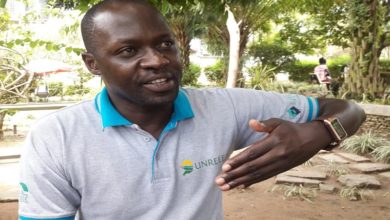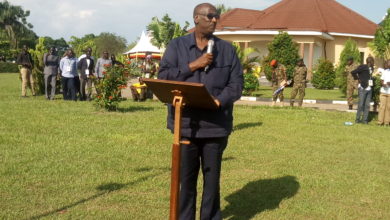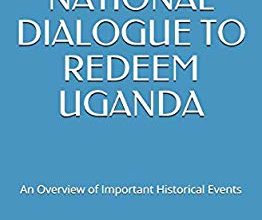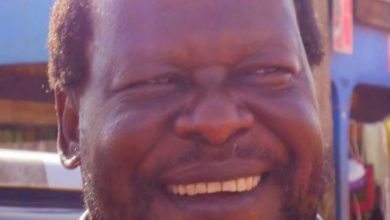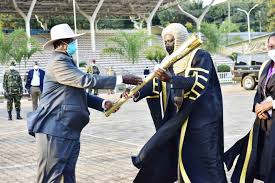
Politics
UGANDA: WAR LOOM IN APAA AS PARLIAMENTARY SELECT COMMITTEE COME OUT, MUSEVENI LOCKED UP IN CLOSE DOOR MEETING WITH ACHOLI LEADERS
Tension is high amidst Acholi community in diaspora as war dram is being beaten

A hundred years ago, West Nile wasnot part of Uganda. Today, it is the onlysub-region in Uganda with an Englishname and a history as chequered, as it isinteresting. John Peter Andrua, 82, the first African information officer of West Nile and former BBC stringer could not agree any more, he says the history of West Nile is enchanting and may well come as a surprise to those who think they know the region well.
The veteran journalist and former teacher, who joined the ministry of information in 1964 says previously the sub-region was known as West Nile Province and then West Nile District. According to Sharon Onyiru, the chairperson of the committee organising the centenary celebrations, it was once “leased for life to King Leopold II of Belgium as a pleasure-hunting ground because the place was full of wild animals.” King Leopold lies interestingly, in order to acquire Congo and subsequently ‘West Nile’,
King Leopold lied to the international community. He set up a private holding company disguised as an international scientific and philanthropic association, which he called the International African Society or the International Association for the Exploration and Civilisation of the Congo.
After some diplomatic maneuvering, which resulted in the Berlin Conference
on African affairs, the Congo Free State, 46 NEW VISION, Monday, April 7, 2014
WEST NILE @ 100 West Niler The THE BIGSTORY
which was 76 times larger than Belgium, was granted to King Leopold II. He controlled the vast area with a private army known as the Force Publique.
Part of Sudan Previously, however, West Nile was part
of the Lado Enclave and its main town was not Arua in Uganda, but Lado, a river
port in southern Sudan. A British-Congolese Treaty in 1894 leased the region to
King Leopold II for life. When Leopold died on December 22, 1909, the region reverted to the British, the following year,”
Onyiru says. Ernest Lulua, 87, a retired teacher, chief and former magistrate in the region during the colonial era is in agreement that West Nile was indeed part of Sudan before
it reverted to Belgian Congo and finally to Uganda.
According to Harold Acemah, a political scientist and retired career diplomat, the Lado Enclave consisted of territory, which today forms part of northern Uganda and
south eastern Sudan. “It was part of the Congo Free State until 1910 when it reverted to Anglo- Egyptian control, as per the
Anglo-German Treaty of 1890,” Acemah says. Available literature also indicates that
during the first decade of the 20th century, the British sought by force to establish total
control over southern Sudan. To achieve this, the Sudan-Uganda border was delimited in 1913 and amended in 1914, when Sudan ceded the southern tip of the Lado Enclave, known
1.4.4 The Presidential Team on Apaa
In an effort to diffuse the tension and resolve the conflict, H.E the President of
the Republic of Uganda in consultation with the Acholi and Madi communities
set up an 18 member Team on Apaa (nine members from each side) to come up
with a solution to the problem. The committee was chaired by the Rt. Hon.
Prime Minister, Hon. Ruhakana Rugunda. The Team was given three options
for consideration to agree on one that would offer a lasting solution to the Apaa
conflict. The options were (Annex VI);
1) Relocation of the people of Apaa elsewhere in Acholi and fully
compensate them;
2) Allow the people to stay on the land by degazetting 25 square Kilometres
of land in the Game Reserve for their settlement; and
3) Get another portion of land in Adjumani to resettle them
The team carried out consultations but failed to come up with an agreeable
option. The Acholi group favoured the option of allowing people of Apaa to stay
on the land by degazetting the whole of Apaa for human settlement and not
just the 25 square kilometers of land as proposed.
The Madi Team on the other hand favored the option of getting another portion
of land in Adjumani, to resettle the Apaa community. This proposal however
had the challenge of there being no available land identified for resettlement,
and the people were as well not willing to be relocated. The Madi team further
argued that there was a lot of land with sparse population in the Acholi subregion where the people in Apaa could be resettled.
When the team failed to agree on a common option, Cabinet on 25ft February
2019 took the following decisions (Annex VI);
W
Page | 7
11.
111
l. Approved a resettlement package of 10 million shillings, 20 bags of
cement and 20 iron sheets to each household with a valid national
identity card registered in Apaa between 2Ol3 and 2Ol4;
Directed that the rest of the households in the reserve be identified and
given shs.2 million and vacate the land,
Directed the Minister of Tourism, Wildlife and Antiquities to instruct
Uganda Wildlife Authority to close the Apaa market by the end of March
2Ol9 and the Minister of Local Government to ensure that an alternative
market is established in the area outside the reserve, and;
1V Authorised the Committee chaired by the Rt. Hon. Prime Minister to
move to the next phase of implementing the Cabinet decision.
However in an attempt to implement the Cabinet decision there were
challenges, and the Presidential committee on Apaa was tasked to reconsider
the matter, under the new leadership of the Rt.Hon. Deputy Speaker, Hon.
Jacob Oulanya.
2.O COMMITTEE FINDINGS AND OBSERVATIONS
2.1 TOR NO. 1: CURRENT STATE OF AFFAIRS RELATING TO
THE LAND CONFLICT IN APAA
2.t.L The settlements and tribes in Apaa
Apaa is predominately occupied by the Acholi ethnic group, followed by the
Madi. Whereas Government places the number of households in the Reserve at
374 (OPM report)r, the community in Apaa put the total population at 26,000
persons. The 2OO2 and 2Ol4 population census indicated the number of
‘ OeU.1ZOt9), Extract of the Report on East Madi Wildlife Reserve Conflict (Apaa Land Conflict)
Page | 8
persons at 1,929 and 11,392 respectivelyz. (Annex VII) This was equivalent to
2,278 households based on the average household size of 5 persons in 2014.
Both the Madi and Acholi communities in Apaa allege that the Political
leadership notably the area Members of Parliament, LC V Chairpersons and
Councilors from both Adjnumani and Amuru districts have encouraged people
to come and settle in Apaa, which allegations were denied by the respective
Political leaders during interaction with the Committee.
The Committee noted that there was evidence of communities having settled in
Apaa, with a community school (Apaa Primary School) that has existed since
the 1970s. There is a claim provided by witnesses that elections were held in
the area in 1980 but this could not be verified by the electoral commission for
lack of past records. There is evidence provided by the Electoral Commission of
the existence of polling stations during the 2006, 2OlI and 2016 general
elections. There is also evidence of graduated tax tickets paid under Gulu
District Administration and a health facility (Apaa Health Centre II) built in
2006 by the Amuru District Local Government and commissioned by the then
Minister of Health.
2.L.2 The Perception of the Community on ownership of land
As mentioned earlier, Apaa is predominantly occupied by the Acholi and some
Madi. The Committee interacted with both the Acholi and Madi communities at
different intervals. The two communities had different versions on how the
ownership of land in Apaa has evolved.
Acholi Community Version
The Acholi claim that before 1911, Amuru including the Apaa area was
occupied by the Parabongo, Toro, Boro, Pagak, Pabbo and Lamogi clans. They
were forcefully evicted on ground that the area was infested with tsetse flies.
‘ UBOS submission on July g, 2olg. Population Census Statistics for Apaa Village, Labala
Parish in Amuru District
w) i
Page | 9
They further allege that in the 193Os people returned to the same land
although the colonial administration had converted the land in question into a
controlled hunting area and that people continued to co-exist with the wildlife.
The committee was also informed that in 1996 the residents of Apaa were again
displaced to the Internally Displaced Peoples Camps (IDPs) due to the LRA
insurgency. In 2006 when the war subsided, Government disbanded the IDPs
and instructed people to return and resettle on their land. The Apaa residents
as well returned to settle on their land.
Madi Community version
The Madi Community informed the Committee that the land comprising the
former East Madi CHA was initially occupied by Madi clans namely; Pajau,
Eranga, Anjevu, Kiraba, Ozupt, Oyupi, Payaru, Ayerepi, Padibe and the Ali.
The people were evicted by the Colonial Government, and relocated to the sub
counties of Pakele and Ciforo, due to the tsetse fly infestation.
From then on, the land was devoid of human settlement and consequently
gazetted as a Controlled Hunting Area and Forest Reserve. The only
settlements in the area were isolated make-shift dwellings by hunters.
They disputed the claim that the land was customarily owned by the Acholi
clans, arguing that the pattern of settlement in Apaa is characterized by mixed
clans living together as opposed to a singular clan which is the norm for
customary ownership. The pattern of settlement is consistent with hunting
communities.
The Madi further claim that during and after tL,e 1979 Liberation war, the Apaa
area was used as a hide out by fugitives, and people who felt insecure to mix in
the communities. During the LRA war, the LRA established its bases in the
ement of the illegal settlers/hunters who then
I
area which led to the
W
Page | 10
camped in the Internally Displaced Peoples Camps outside the reserve, near
Ome River and other places in Amuru
In fighting the LRA, Government constructed security roads, including one
going through the East Madi Wildlife Reserve. The current settlement in the
area was a result of the large number of people from Acholi sub-region that
moved in, taking advantage of the road and the relative peace, and established
Apaa IDP camp inside East Madi Wildlife Reserve, along the security road.
They further informed the Committee that in 2006, people moved from Pabo
IDP camp and settled in Apaa and adjacent areas such as Zoka C.
They alleged that the political leaders of Acholi sub-region were ferrying people
into Apaa, claiming customary ownership of the land.
Obsenration
The Committee observed that the Acholi and the Madi communities have
divergent narratives on the history and ownership of land in Apaa. The Acholi
version connotes to the fact that the land has always been occupied by the
Acholi clans exclusively. On the other hand the Madi Community claim the
land was owned and occupied by mixed communities and many of the Acholi
had only been encouraged by politicians from Acholi to come and settle on the
land.
2.L.3 Nature of the conflict
The Committee identified three dimensions to the conflict in Apaa. There was a
conflict between Uganda Wildlife Authority and the residents of Apaa; the
border dispute between Amuru and Adjumani districts, and the Tribal Conflict
rn Zoka between the Acholi and the Madi over land.
Page | 11
7. The conflict betuteen |IWA and residents of Apaa
The conflict in Apaa within the Reserve is between the residents who claim
customary ownership of the land and UWA that has the mandate to manage all
the wildlife reserves. It was on this basis that UWA moved in to evict the people
who had settled in the Wildlife Reserve. The eviction was resisted leading to
confrontation.
2. Border dispute between Amunt and Adjumani
The border dispute between Adjumani and Amuru and encroachment of the
East Madi Wild Reserve started in 2OO7. This culminated into a meeting of
Amuru and Adjumani district leaders, UWA, and other stakeholders (Annex
vru.
Arising out of the meeting, a joint request to the Rt. Hon. Prime Minister by
the Chairperson Local Government V of Amuru and Adjumani was written on
20ft of November 2OO7 for an urgent intervention to have a border re-opening
exercise carried out and the encroachment on the Reserve stopped (Annex
IXl. This request however was not acted on immediately, and the rise in
tensions due to the unresolved border issue ensued.
The District leaders from the two districts conducted joint consultative
meetings in Gulu on the 22″d of January 2015, where a joint team was set up
to sensitize the community on the planned boundary re-opening. The
sensitization was carried out between 4th – 6th March,2015 in the areas of
Zoka and Apaa trading center, with the objective of informing them about the
planned border re-opening and demarcation. (Annex X).
In 2017, a border re-opening exercise was undertaken by the Ministry of
Lands, Housing, and Urban Development, and a declaration was made by the
Minister of Local Government on 13ft October 20 17. The boundaries that were
reopened are described as follows;
W Page | ).2
1. District Boundary
iCommencing at the point uthere the Riuer Choro enters the Albert Nile;
thence in a straight line in a north-easterlg direction to the source of the
Riuer Ceri”
2. East Madi CHA
lCommencing at the confluence of the Riue Asiga uith the Albert Nile,
thence following in turn to northern banks of the riuers Asiya and Ofoa
to the source of the latter; thence easterly in a straight line to the top of
the Arawa Hill; thence in a straigltt line to the junction of tLrc Okwa and
Eradzi riuers; thence along the east bank of the Eradzi Riuer to its
source; thence easterlg direction in a straight line to the source of the
Umuu Riuer; thence following the north bank of the Umuu Riuer to its
confluence with Cei Riuer whiclt is at this point the Madi-Acholi District
boundary; thence following the Madi-Acholi District boundary in a
southerlg then westerlg direction to the Albert Nile Riuer; thence
following the Albert Nile to the point of the commencement.”l4aaen__Xll
It is worth noting that the representatives of the Acholi community did not
participate in the exercise, and rejected its outcome alleging that it was in
contravention of the High Court order in Miscellaneous application No.004
of 2Ol2 that issued an injunction against the Uganda Wildlife Authority and
Attorney General and their agents or servants from any eviction,
destruction, confiscation or conversion and or interfering with the land
rights, occupation and the uses of the land belonging to the applicants in
the areas of Lakang, Pabbo and Apaa in Amuru District.
Besides they were skeptical about the series of the maps used suspecting
them of having been altered.

